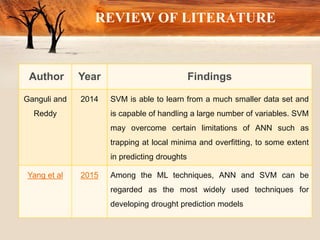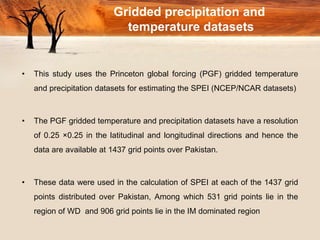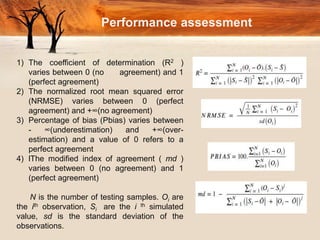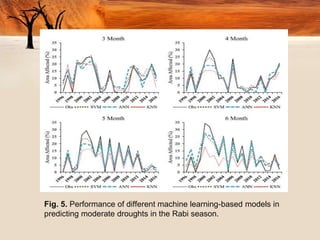Prediction droughts using machine learning algorithm
- 1. Prediction of droughts over Pakistan using machine learning algorithms Presented By KARTIK JADAV(19AG62R19) Agricultural and Food Engineering Department, Indian Institute of Technology Kharagpur, India Reference : Najeebullah Khan, D.A. Sachindra , Shamsuddin Shahid , Kamal Ahmed a , Mohammed Sanusi Shiru , Nadeem Nawaz “Prediction of droughts over Pakistan using machine learning algorithms ”, Advances in Water Resources(2020) Volume 139, May 2020, 103562
- 2. Motivation Why study had been done? The main objective of this study was to develop ML-based models for predicting moderate, severe and extreme droughts over Pakistan based on the SPEI. Context of the study In this study, the drought prediction models were developed using ANN, SVM and KNN. Contribution As droughts have a direct relationship with the availability of water, their changing characteristics due to changing climate will have a pro- found impact on water stress and food security.
- 3. REVIEW OF LITERATURE Author Year Findings Ganguli and Reddy 2014 SVM is able to learn from a much smaller data set and is capable of handling a large number of variables. SVM may overcome certain limitations of ANN such as trapping at local minima and overfitting, to some extent in predicting droughts Yang et al 2015 Among the ML techniques, ANN and SVM can be regarded as the most widely used techniques for developing drought prediction models
- 4. Study area and datasets • Pakistan located in South Asia covers an area of 796,095 km2. • Pakistan experiences two monsoon precipitation seasons; IM (July–Sep), WD (Dec–Mar). Fig. 1. IM refers to the regions which receive precipitation mainly during the Indian monsoon and WD refers to the regions which receive precipitation mainly during the western disturbance.
- 5. • It experiences four seasons (based on temperature) cool and dry winter (Dec–Feb), hot and dry spring (Mar–May), hot and humid summer (Jun–Aug) and dry autumn (Sep–Nov) • During these two precipitation seasons, two important cropping seasons called Kharif (May-Oct) observed during the Indian monsoon period • The Rabi (Nov-Apr) is experienced during the western disturbances • These cropping seasons play an important role in agriculture and the economy of Pakistan
- 6. Gridded precipitation and temperature datasets • This study uses the Princeton global forcing (PGF) gridded temperature and precipitation datasets for estimating the SPEI (NCEP/NCAR datasets) • The PGF gridded temperature and precipitation datasets have a resolution of 0.25 ×0.25 in the latitudinal and longitudinal directions and hence the data are available at 1437 grid points over Pakistan. • These data were used in the calculation of SPEI at each of the 1437 grid points distributed over Pakistan, Among which 531 grid points lie in the region of WD and 906 grid points lie in the IM dominated region
- 7. Method 1–6-month SPEIs were calculated for each of the grid points Based on 1–6-month SPEIs droughts were categorized Different large-scale atmospheric variables (probable predictors) that are influential on droughts were identified based on past literature Principle Component Analysis (PCA) was used to generate the Principal Components (PCs) from the data The difference between the PCs for February and April(Kharif) and difference between the PCs for October and August(Rabi) were computed. The PCs selected using SVM-RFE they were used in the development of drought prediction models the correlations between the PCs and 1–6-month SPEI were separately calculated ML-algorithms were used to develop drought prediction
- 8. PCA Why? • Overfitting (Due to too much features and attribute we gave during training phase so model is confused and problem of overfitting occur) • PCA is Linear projection method to reduce number of parameters(Attributes and features). 1. Standardize the data 2. Calculate the covariance matrix 3. Find the eigenvalues and eigenvectors of covariance matrix 4. Plot the eigenvectors/principal components over scaled data
- 9. SVM • SVM is a widely used ML algorithm that can be used in developing classification and regression models. • However, Sachindra et al. (2018) showed that the polynomial kernel performs better with SVM. Hence, the polynomial kernel was used in this study. • The polynomial kernel is defined as . 𝐾 (𝑥 𝑖 , 𝑥 𝑗 )= (𝑥 𝑖 . 𝑥 𝑗 + 𝑐 ) 𝑑 Where, 𝑥 𝑖 and 𝑥 𝑗 are the predictor and predictand data, d is the degree of the polynomial, and c is a constant that allows a trade-off between the influence of the higher and lower order terms.
- 10. ANN • .To reduce the chances of overfitting, a technique known as Bayesian regularization was developed ( Burden and Winkler, 2008 ; MacKay, 1992 ; Ticknor, 2013 ). 𝐹 = 𝛽E D + 𝛼E w • In the Bayesian network, the weights are considered random variables and thus their density function is expressed following the Bayes’ rules 𝑃 ( 𝑤 |𝐷, 𝛼, 𝛽, M) = 𝑃 (D |w , 𝛽, M) P(w |𝛼, M) 𝑃 (D |𝛼, 𝛽, M) Where w is the vector of network weights, D represents the predictor and the predictand data vectors (x, y), and M is the neural network model being used, 𝛼 and 𝛽 are Regularization
- 11. K-Nearest Neighbour • The KNN for classification and regression is the simplest non-parametric ML techniques • KNN algorithm finds the k Nearest Neighbours from calibration data using a distance measure such as the Euclidean distance 𝑑 𝑗𝑜 = 𝑖=1 ݊ (𝑥 𝑖𝑗 − 𝑥 𝑖𝑜 )2 𝑡 = 1 , 2 , 3 , …., ݊ • For calculating KNN simulated values ( Zr ) Zk refers to the neighbouring data and f k ( dj ) is the kernel function 𝑍 𝑟 = ݇ =1 𝐾 ݂݇ (𝑑𝑗 ×𝑍݇ ).
- 12. Performance assessment 1) The coefficient of determination (R2 ) varies between 0 (no agreement) and 1 (perfect agreement) 2) The normalized root mean squared error (NRMSE) varies between 0 (perfect agreement) and +∞(no agreement) 3) Percentage of bias (Pbias) varies between - ∞(underestimation) and +∞(over- estimation) and a value of 0 refers to a perfect agreement 4) lThe modified index of agreement ( md ) varies between 0 (no agreement) and 1 (perfect agreement) N is the number of testing samples. Oi are the ith observation, Si are the i th simulated value, sd is the standard deviation of the observations.
- 13. Results and Discussion Fig. 2. Climate domain used in the present study, 861 NCEP/NCAR grid points spread across the climate domain are depicted in grey circles.
- 14. Fig. 3. The spatial pattern of the correlation coefficient of the RH, atm temperature and wind component (925hPa) during the Rabi and Kharif periods. The correlation is calculated with 6-month SPEI in April for Rabi and in October for Kharif. The dots represent the significant correlation at 95% confidence level with the SPEI.
- 15. Fig. 4. Boxplots showing correlations of the selected atmospheric variables at four pressure levels i.e. 925, 850, 700 and 500 hPa (except SLP) with the SPEI of Pakistan Red boxplots (Rabi season) Blue (Kharif season)
- 16. Fig. 5. Performance of different machine learning-based models in predicting moderate droughts in the Rabi season.
- 17. Fig. 6. Performance of different machine learning-based models in predicting moderate droughts in the Kharif season.
- 18. Fig.7. Boxplots of the spatial correlation and NRMSE for the Rabi and Kharif seasons for the month of April shown in red and blue colours respectively.
- 19. Conclusions • In this study, it was seen that KNN-based drought models display limited performance comparison to other drought models • SVM-based models were able to better capture the temporal and spatial characteristics of droughts • It was found that in the Rabi season SPEI is positively correlated with RH over the Mediterranean Sea and the region north of the Caspian Sea, whereas in the Kharif season SPEI is positively correlated with the humid region over the south-eastern part of the Bay of Bengal and Caspian Seas.
- 20. • Rabi season SPEI also displayed statistically significant positive correlations with atmospheric temperature over the region north of the Mediterranean Sea. • Also, wind speeds over the Indian Ocean and the Arabian Sea during the Kharif season were statistically significantly correlated with SPEI . • This indicated that RH, temperature and wind speed are indicators of droughts over Pakistan.
- 21. Limitations of this study • The present study used only one reanalysis dataset (NCEP/NCAR) to provide inputs to the drought prediction models. • In order to study the uncertainties which originate from the inputs, different reanalysis datasets should be used in developing drought prediction models. • However, this was not performed as the other major reanalysis datasets either did not have data for some of the specific atmospheric variables used in this study or they did not have data corresponding to the period 1948– 2016.
- 22. Future scope • Sachindra and Kanae (2019) proved that Parallel Multi-Population Genetic Programming (PMPGP)-based statistical downscaling models show better generalization skills and higher resistance to redundant information in inputs compared to those based on traditional GP. • Thus, other ML algorithms such as Extreme Learning Machine (ELM), Genetic Programming (GP), PMPGP, and Random Forest (RF) should also be tested in future for developing drought prediction models over Pakistan.
- 23. References • Najeebullah Khan, D.A. Sachindra , Shamsuddin Shahid , Kamal Ahmed a , Mohammed Sanusi Shiru , Nadeem Nawaz “Prediction of droughts over Pakistan using machine learning algorithms ”, Advances in Water Resources(2020) Volume 139, May 2020, 103562 • Ganguli, P. , Reddy, M.J. , 2014. Ensemble prediction of regional droughts using climate inputs and the SVM–copula approach. Hydrol. Process. 28, 4989–5009
























